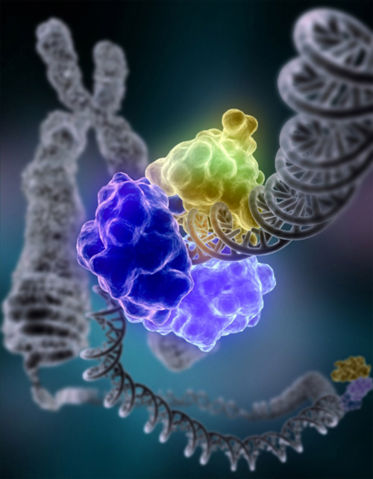Image:DNA Repair.jpg
From Wikipedia, the free encyclopedia
 Size of this preview: 373 × 479 pixels
Size of this preview: 373 × 479 pixels Full resolution (500 × 642 pixels, file size: 109 KB, MIME type: image/jpeg)
 |
This is a file from the Wikimedia Commons. The description on its description page there is shown below.Commons is a freely licensed media file repository. You can help.
|
Summary
| Description |
DNA damage, due to environmental factors and normal metabolic processes inside the cell, occurs at a rate of 1,000 to 1,000,000 molecular lesions per cell per day. A special enzyme, DNA ligase (shown here in colour), encircles the double helix to repair a broken strand of DNA. DNA ligase is responsible for repairing the millions of DNA breaks generated during the normal course of a cell's life. Without molecules that can mend such breaks, cells can malfunction, die, or become cancerous. DNA ligases catalyse the crucial step of joining breaks in duplex DNA during DNA repair, replication and recombination, and require either Adenosine triphosphate (ATP) or Nicotinamide adenine dinucleotide (NAD+) as a cofactor. Shown here is DNA ligase I repairing chromosomal damage. The three visable protein structures are:
- The DNA binding domain (DBD) which is bound to the DNA minor groove both upstream and downstream of the damaged area.
- The OB-fold domain (OBD) unwinds the DNA slightly over a span of six base pairs and is generally involved in nucleic acid binding.
- The Adenylation domain (AdD) contains enzymatically active residues that join the broken nucleotides together by catalyzing the formation of an internucleotide ester bond between phosphate and deoxyribose.
It is likely that all mammalian DNA ligases (Ligases I, III, and IV) have a similar ring-shaped architecture and are able to recognize DNA in a similar manner. (See: Nature Article 2004, PDF) |
| Source |
Biomedical Beat National Institute of General Medical Science (NIGMS) Cool Image Gallery |
| Date |
November 21, 2006 |
| Author |
Courtesy of Tom Ellenberger, Washington University School of Medicine in St. Louis. |
Permission
( Reusing this image) |
"The material in this newsletter is not copyrighted and we encourage its use or reprinting."
|
Licensing
 |
This work is in the public domain in the United States because it is a work of the United States Federal Government under the terms of Title 17, Chapter 1, Section 105 of the US Code. See Copyright. Note: This only applies to works of the Federal Government and not to the work of any individual U.S. state, territory, commonwealth, county, municipality, or any other subdivision. This template also does not apply to postage stamps published by the United States Postal Service. (See 206.02(b) of Compendium II: Copyright Office Practices).
العربية | Български | Česky | Deutsch | English | Español | Français | Magyar | Italiano | 日本語 | 한국어 | Polski | Português | 中文(繁體) | 中文(简体) | +/- |
|
File history
Click on a date/time to view the file as it appeared at that time.
|
|
Date/Time |
Dimensions |
User |
Comment |
| current |
01:11, 27 January 2007 |
500×642 (109 KB) |
DO11.10 |
|
File links
The following pages on Schools Wikipedia link to this image (list may be incomplete):
This file contains additional information, probably added from the digital camera or scanner used to create or digitize it. If the file has been modified from its original state, some details may not fully reflect the modified file.


